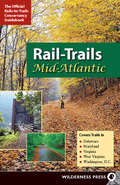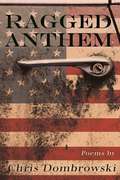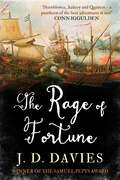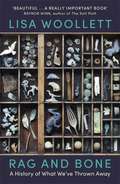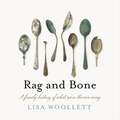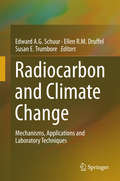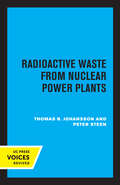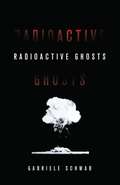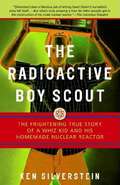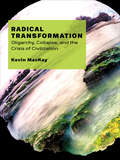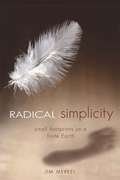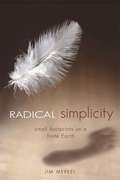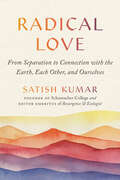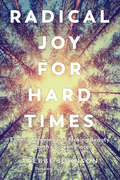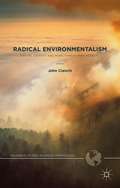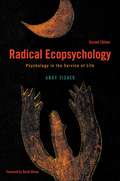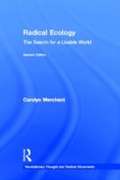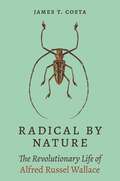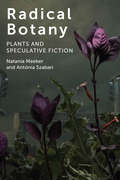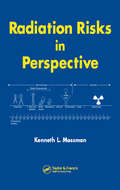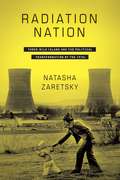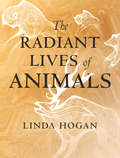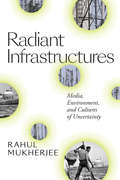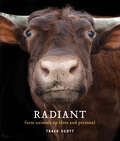- Table View
- List View
Rail-Trails Mid-Atlantic
by Rails-to-Trails-ConservancyThe official guidebooks for the nationwide rail-trails system, the new Rail-Trails series books have an easy-to-use layout and design, clear maps, and precise trip descriptions. With more than 65 rural, suburban, and urban trails spanning 800 miles, Rail-Trails Mid-Atlantic covers trails in Delaware, Maryland, Virginia, Washington, D.C., and West Virginia. Stroll through shady pines and deep forests, visit a Christmas tree farm, and watch grazing llamas along the mid-Atlantic's historic rail-trails. Includes two-color maps for each trip and succinct directions.
Ragged Anthem (Made in Michigan Writers Series)
by Chris DombrowskiRagged Anthem displays the same inimitable voice and unflinching gaze that made Chris Dombrowski a Poetry Foundation bestseller and silver medal winner of Foreword Reviews’ Book of the Year Award in poetry. His work has been celebrated by renowned writers such as Jim Harrison and Alicia Ostriker, who have called his books (respectively) "extraordinarily powerful and graceful" and "one of the most beautiful books of poetry I’ve read in years." As in Dombrowski’s previous books, in Ragged Anthem the natural world is as alive and as fully realized as language allows. His comfort with the naming of the world, combined with a life lived intimately with the other species that populate the landscape of home, suggest an authenticity that few can claim. Ragged Anthem is a demonstration in continued poetic growth and expanded terrain. Written from the speaker’s midlife, the poems delve into the transformation of family, childhood tragedies, and politics. Dombrowski lifts the veil on the imbecilic bureaucracies—those on Capitol Hill and in the faculty meetings occurring in our own conference rooms—that often help to whittle our fates. The book contains well-placed and evocative allusions to such figures as American painter Mark Rothko and Saint Francis of Assisi, as well as the periodic highlighting of language from contemporary song lyrics. These "borrowings" set forth a conversation between the poet and other artists that evoke the original source while transforming it into something new, proving that words, although artifice, live within our bodies, changing our relationship to place. Ragged Anthem makes a powerful and important contribution to contemporary poetry. Fans of Dombrowski’s past works and newcomers alike will bask in the poet’s firm yet relaxed approach to the shaping of language.
The Rage of Fortune (The Matthew Quinton Journals)
by J. D. DaviesThis prequel to the &“excellent&” Matthew Quinton Journals series reveals the legacy of the Royal Navy captain (Publishers Weekly). In 1651, eleven-year-old Matthew Quinton and his twin sister Henrietta discover long-forgotten papers of their grandfather. Dating back to 1598, they show the children an England locked into a bitter war with Spain. But their findings are interrupted by the arrival of Roundhead troops intent on searching for their elder brother, the tenth Earl of Ravensden, who has been seriously wounded in the Cavalier cause. Back in the present of 1651, England&’s enemies are closer to home, with the country gripped by civil war. Now the Roundheads are closing in . . . Set against the backdrop of real historical events The Rage of Fortune is a window into Mathew Quinton&’s origins. Praise for the writing of J. D. Davies: &“Hornblower, Aubrey and Quinton—a pantheon of the best adventures at sea!&” —Conn Iggulden, #1 New York Times–bestselling author of The Conqueror and War of the Roses series &“A hero worth rooting for.&” —Publishers Weekly &“Utterly impossible to put down . . . Finely-shaded characters, excellent plotting, gut-clenching action and immaculate attention to period detail . . . Superb.&” —Angus Donald, author of The Outlaw Chronicles series &“Destined to be a classic of nautical adventure series.&” —Eric Jay Dolin, author of Leviathan and Fur, Fortune, and Empire &“A naval adventure that goes well beyond the usual outlines of the genre to paint a lively portrait of England in the 1600s.&” —Kirkus Reviews
Rag and Bone: A Family History of What We've Thrown Away
by Lisa Woollett'Beautiful, like a muddy journey through time . . . a really important book' RAYNOR WINN, author of The Salt Path Lisa Woollett has spent her life combing beaches and mudlarking, collecting curious fragments of the past: from Roman tiles and Tudor thimbles, to Victorian buttons and plastic soldiers. In a series of walks from the Thames, out to the Kentish estuary and eventually to Cornwall, she traces the history of our rubbish and, through it, reveals the surprising story of our changing consumer culture.Timely and beautifully written, Rag and Bone shows what we can learn from what we've thrown away and urges us to think more about what we leave behind.
Rag and Bone: A Family History of What We've Thrown Away
by Lisa Woollett'Beautiful, like a muddy journey through time . . . a really important book' RAYNOR WINN, author of The Salt Path Lisa Woollett has spent her life combing beaches and mudlarking, collecting curious fragments of the past: from Roman tiles and Tudor thimbles, to Victorian buttons and plastic soldiers. In a series of walks from the Thames, out to the Kentish estuary and eventually to Cornwall, she traces the history of our rubbish and, through it, reveals the surprising story of our changing consumer culture.Timely and beautifully written, Rag and Bone shows what we can learn from what we've thrown away and urges us to think more about what we leave behind.
Rag and Bone: A Family History of What We've Thrown Away
by Lisa WoollettFrom relics of Georgian empire-building and slave-trading, through Victorian London's barged-out refuse to 1980s fly-tipping and the pervasiveness of present-day plastics, Rag and Bone traces the story of our rubbish, and, through it, our history of consumption.In a series of beachcombing and mudlarking walks - beginning in the Thames in central London, then out to the Kentish estuary and eventually the sea around Cornwall - Lisa Woollett also tells the story of her family, a number of whom made their living from London's waste, and who made a similar journey downriver from the centre of the city to the sea.A beautifully written but urgent mixture of social history, family memoir and nature writing, Rag and Bone is a book about what we can learn from what we've thrown away - and a call to think more about what we leave behind.(p) 2020 Hodder & Stoughton Ltd
Radiocarbon and Climate Change
by Edward A. G. Schuur Ellen R. M. Druffel Susan E. TrumboreThis book is a useful guide for researchers in ecology and earth science interested in the use of accelerator mass spectrometry technology. The development of research in radiocarbon measurements offers an opportunity to address the human impact on global carbon cycling and climate change. Presenting radiocarbon theory, history, applications, and analytical techniques in one volume builds a broad outline of the field of radiocarbon and its emergent role in defining changes in the global carbon cycle and links to climate change. Each chapter presents both classic and cutting-edge studies from different disciplines involving radiocarbon and carbon cycling. The book also includes a chapter on the history and discovery of radiocarbon, and advances in radiocarbon measurement techniques and radiocarbon theory. Understanding human alteration of the global carbon cycle and the link between atmospheric carbon dioxide levels and climate remains one of the foremost environmental problems at the interface of ecology and earth system science. Many people are familiar with the terms 'global warming' and 'climate change', but fewer are able to articulate the science that support these hypotheses. This book addresses general questions such as: what is the link between the carbon cycle and climate change; what is the current evidence for the fate of carbon dioxide added by human activities to the atmosphere, and what has caused past changes in atmospheric carbon dioxide? How can the radiocarbon and stable isotopes of carbon combined with other tools be used for quantifying the human impact on the global carbon cycle?
Radioactive Waste from Nuclear Power Plants
by Thomas B. Johansson Peter SteenThis title is part of UC Press's Voices Revived program, which commemorates University of California Press’s mission to seek out and cultivate the brightest minds and give them voice, reach, and impact. Drawing on a backlist dating to 1893, Voices Revived makes high-quality, peer-reviewed scholarship accessible once again using print-on-demand technology. This title was originally published in 1981.
Radioactive Ghosts (Posthumanities #61)
by Gabriele SchwabA pioneering examination of nuclear trauma, the continuing and new nuclear peril, and the subjectivities they generate Amid resurgent calls for widespread nuclear energy and &“limited nuclear war,&” the populations that must live with the consequences of these decisions are increasingly insecure. The nuclear peril combined with the looming threat of climate change means that we are seeing the formation of a new kind of subjectivity: humans who are in a position of perpetual ontological insecurity. In Radioactive Ghosts, Gabriele Schwab articulates a vision of these &“nuclear subjectivities&” that we all live with. Focusing on the legacies of the Manhattan Project, Hiroshima, and nuclear energy politics, Radioactive Ghosts takes us on a tour of the little-seen sides of our nuclear world. Examining devastating uranium mining on Native lands, nuclear sacrifice zones, the catastrophic accidents at Chernobyl and Fukushima, and the formation of a new transspecies ethics, Schwab shows how individuals threatened with extinction are creating new adaptations, defenses, and communal spaces. Ranging from personal accounts of experiences with radiation to in-depth readings of literature, film, art, and scholarly works, Schwab gives us a complex, idiosyncratic, and personal analysis of one of the most overlooked issues of our time.
The Radioactive Boy Scout: The Frightening True Story of a Whiz Kid and His Homemade Nuclear Reactor
by Ken SilversteinThrowing caution to the wind, David Hahn plunged into a new project: building a model nuclear reactor in his backyard garden shed. Posing as a physics professor, David solicited information on reactor design from the U.S. government and from industry experts. Following blueprints he found in an outdated physics textbook, David cobbled together a crude device that threw off toxic levels of radiation. His wholly unsupervised project finally sparked an environmental emergency that put his town's forty thousand suburbanites at risk. The EPA ended up burying his lab at a radioactive dump site in Utah. This offbeat account of ambition and, ultimately, hubris has the narrative energy of a first-rate thriller.
Radical Transformation: Oligarchy, Collapse, and the Crisis of Civilization
by Kevin MacKayRadical Transformation is a story about industrial civilization’s impending collapse, and about the possibilities of averting this fate. Human communities first emerged as egalitarian, democratic groups that existed in symbiotic relationship with their environments. Increasing complexity led to the emergence of oligarchy, in which societies became captive to the logic of domination, exploitation, and ecological destruction. The challenge facing us today is to build a movement that will radically transform civilization and once more align our evolutionary trajectory in the direction of democracy, equality, and ecological sustainability.
Radical Simplicity: Small Footprints on a Finite Earth
by Jim MerkelImagine you are first in line at a potluck buffet. The spread includes not just food and water, but all the materials needed for shelter, clothing, healthcare, and education. How do you know how much to take? How much is enough to leave for your neighbours behind you -- not just the six billion people, but the wildlife, and the as-yet-unborn? In the face of looming ecological disaster, many people feel the need to change their own lifestyles as a tangible way of transforming our unsustainable culture. Radical Simplicity is the first book that guides the reader to a personal sustainability goal, then offers a process to monitor progress to a lifestyle that is equitable amongst all people, species, and generations. Combining lyrical narrative, compassionate advocacy and absorbing science, Radical Simplicity is a practical, personal answer to 21st century challenges that will appeal as much to Cultural Creatives and students as to spiritual seekers, policy makers and sustainability professionals.
Radical Simplicity
by Jim MerkelImagine you are first in line at a potluck buffet. The spread includes not just food and water, but all the materials needed for shelter, clothing, healthcare, and education. How do you know how much to take? How much is enough to leave for your neighbors behind you--not just the six billion people, but the wildlife, and the as-yet-unborn? In the face of looming ecological disaster, many people feel the need to change their own lifestyles as a tangible way of transforming our unsustainable culture. Radical Simplicity is the first book that guides the reader to a personal sustainability goal, then offers a process to monitor progress to a lifestyle that is equitable amongst all people, species, and generations. It employs three tools to help readers begin their customized journey to simplicity: >It builds on steps from Your Money or Your Life so readers can design their own personal economics to save money, get free of debt, and align their work with their values.It uses refined tools from Our Ecological Footprint so readers can measure how much nature is needed to supply all they consume and absorb their waste.Combining lyrical narrative, compassionate advocacy, and absorbing science, Radical Simplicity is a practical, personal answer to twenty-first century challenges that will appeal as much to Cultural Creatives and students as to spiritual seekers, policy makers, and sustainability professionals.
Radical Love: From Separation to Connection with the Earth, Each Other, and Ourselves
by Satish KumarTo see peace in our lifetimes, we have to practice love.This is the radical message of this inspirational book of pithy advice from environmental activist Satish Kumar, which helps us find ways to love ourselves, others, and all beings on planet Earth—even those we may find unlovable.Satish Kumar is well known for his epic walk for world peace in his youth in the 1960s from India to the nuclear capitals of Moscow, Paris, London, and Washington, DC. Wherever he traveled, he found that human beings were capable of a love that could overcome hatred and division. Settling down in the UK, he married his wife, June Mitchell, and founded eco-university Schumacher College in Devon, eventually becoming a leading figure in the UK green movement.Radical Love distills the author's lifetime of experience as a lover, parent, activist, and educator into simple lessons on transforming our time of ecological crisis, conflict, and scarcity into one in which we experience harmony with nature, safety, and abundance. It is an exploration of the transformative power of love in all its forms, from romantic love to love for one's family and community to love for the planet and all beings. Kumar's approach is founded on simplicity (including the Jain principle of aparigraha), generosity, and continuous learning. Like an unfolding metta meditation, the book expands our notions of love to its most sublime universal state and makes a great gift to share with those we love.
Radical Joy for Hard Times: Finding Meaning and Making Beauty in Earth's Broken Places
by Susan Griffin Trebbe JohnsonIn a world devastated by human interaction and natural disaster—from clearcutting and fracking to extreme weather and urban sprawl—creating art, ritual, and even joy in wounded places is essential to our collective healing When a beloved place is decimated by physical damage, many may hit the donate button or call their congressperson. But award-winning author Trebbe Johnson argues that we need new methods for coping with these losses and invites readers to reconsider what constitutes “worthwhile action.” She discusses real wounded places ranging from weapons-testing grounds at Eglin Air Force Base, to Appalachian mountain tops destroyed by mining. These stories, along with tools for community engagement—ceremony, vigil, apology, and the creation of art with on-site materials—show us how we can find beauty in these places and discover new sources of meaning and community.
Radical Environmentalism: Nature, Identity and More-than-human Agency
by John CianchiEnvironmentalism is a contest about the meaning of nature and the social construction of activism, deviance and harm. The contests that are the subject of this book are fought on the margins, in spaces where what is deviant and what is criminal are fluid concepts. Forest activists engaged in Tasmania's old-growth forests, and Sea Shepherd Conservation Society activists campaigning in the Southern Ocean to protect whales tell powerful and moving stories about their encounters with nature. These are profound experiences that fundamentally alter how they understand themselves and their world. What emerges in this book is a perspective that recognises the personhood of non-humans and which gives rise to a strong moral obligation to defend nature from harm. Providing a unique account of environmentalism, one that highlights the voices of the activists and the nature they defend, Radical Environmentalism: Nature, Identity and More-than-human Agency will be of great interest to students and academics of green criminology, environmental sociology and nature–human studies more broadly.
Radical Ecopsychology: Psychology in the Service of Life (2nd Edition) (SUNY series in Radical Social and Political Theory)
by Andy FisherA provocative look at the philosophical concepts (and conceits) that underlie what truly is a radical new form of social thought.
Radical Ecology: The Search for a Livable World (2nd edition)
by Carolyn MerchantIn the first edition of Radical Ecology--the now classic examination major philosophical, ethical, scientific, and economic roots of environmental problems--Carolyn Merchant responded to the profound awareness of environmental crisis which prevailed in the closing decade of the twentieth century. In this provocative and readable study, Merchant examines the ways that radical ecologists can transform science and society in order to sustain life on this planet. Now in this second edition, Merchant continues to emphasize how laws, regulations and scientific research alone cannot reverse the spread of pollution or restore our dwindling resources. Merchant argues that in order to maintain a livable world, we must formulate new social, economic, scientific, and spiritual approaches that will fundamentally transform human relationships with nature. She analyzes the revolutionary ideas of visionary ecologists for a new economy, society, science, and religion, and examines their efforts to bring environmental problems to the attention of the public. This new edition features a new Introduction from the author, a thorough updating of chapters, and two entirely new chapters on recent global movements and globalization and the environment. It is a timely update that will give students everything they need to know on the most recent philosophical positions and social movements that characterize the radical ecology spectrum.
Radical by Nature: The Revolutionary Life of Alfred Russel Wallace
by James T. CostaA major new biography of the brilliant naturalist, traveler, humanitarian, and codiscoverer of natural selectionAlfred Russel Wallace (1823–1913) was perhaps the most famed naturalist of the Victorian age. His expeditions to remote Amazonia and southeast Asia were the stuff of legend. A collector of thousands of species new to science, he shared in the discovery of natural selection and founded the discipline of evolutionary biogeography.Radical by Nature tells the story of Wallace’s epic life and achievements, from his stellar rise from humble origins to his complicated friendship with Charles Darwin and other leading scientific lights of Britain to his devotion to social causes and movements that threatened to alienate him from scientific society.James Costa draws on letters, notebooks, and journals to provide a multifaceted account of a revolutionary life in science as well as Wallace’s family life. He shows how the self-taught Wallace doggedly pursued bold, even radical ideas that caused a seismic shift in the natural sciences, and how he also courted controversy with nonscientific pursuits such as spiritualism and socialism. Costa describes Wallace’s courageous social advocacy of women’s rights, labor reform, and other important issues. He also sheds light on Wallace’s complex relationship with Darwin, describing how Wallace graciously applauded his friend and rival, becoming one of his most ardent defenders.Weaving a revelatory narrative with the latest scholarship, Radical by Nature paints a mesmerizing portrait of a multifaceted thinker driven by a singular passion for science, a commitment to social justice, and a lifelong sense of wonder.
Radical Botany: Plants and Speculative Fiction
by Natania Meeker Antónia SzabariRadical Botany excavates a tradition in which plants participate in the effort to imagine new worlds and envision new futures. Modernity, the book claims, is defined by the idea of all life as vegetal. Meeker and Szabari argue that the recognition of plants’ liveliness and animation, as a result of scientific discoveries from the seventeenth century to today, has mobilized speculative creation in fiction, cinema, and art. Plants complement and challenge notions of human life. Radical Botany traces the implications of the speculative mobilization of plants for feminism, queer studies, and posthumanist thought. If, as Michael Foucault has argued, the notion of the human was born at a particular historical moment and is now nearing its end, Radical Botany reveals that this origin and endpoint are deeply informed by vegetality as a form of pre- and posthuman subjectivity. The trajectory of speculative fiction which this book traces offers insights into the human relationship to animate matter and the technological mediations through which we enter into contact with the material world. Plants profoundly shape human experience, from early modern absolutist societies to late capitalism’s manipulations of life and the onset of climate change and attendant mass extinction.A major intervention in critical plant studies, Radical Botany reveals the centuries-long history by which science and the arts have combined to posit plants as the model for all animate life and thereby envision a different future for the cosmos.
Radiation Risks in Perspective
by Kenneth L. MossmanPublic misperception of radiological risk consistently directs limited resources toward managing minimal or even phantom risks at great cost to government and industry with no measurable benefit to overall public health. The public's inability to comprehend small theoretical risks arrived at through inherently uncertain formulae, coupled with an ir
Radiation Nation: Three Mile Island and the Political Transformation of the 1970s
by Natasha ZaretskyOn March 28, 1979, the worst nuclear reactor accident in U.S. history occurred at the Three Mile Island power plant in Central Pennsylvania. Radiation Nation tells the story of what happened that day and in the months and years that followed, as local residents tried to make sense of the emergency. The near-meltdown occurred at a pivotal moment when the New Deal coalition was unraveling, trust in government was eroding, conservatives were consolidating their power, and the political left was becoming marginalized. Using the accident to explore this turning point, Natasha Zaretsky provides a fresh interpretation of the era by disclosing how atomic and ecological imaginaries shaped the conservative ascendancy.Drawing on the testimony of the men and women who lived in the shadow of the reactor, Radiation Nation shows that the region's citizens, especially its mothers, grew convinced that they had sustained radiological injuries that threatened their reproductive futures. Taking inspiration from the antiwar, environmental, and feminist movements, women at Three Mile Island crafted a homegrown ecological politics that wove together concerns over radiological threats to the body, the struggle over abortion and reproductive rights, and eroding trust in authority. This politics was shaped above all by what Zaretsky calls "biotic nationalism," a new body-centered nationalism that imagined the nation as a living, mortal being and portrayed sickened Americans as evidence of betrayal. The first cultural history of the accident, Radiation Nation reveals the surprising ecological dimensions of post-Vietnam conservatism while showing how growing anxieties surrounding bodily illness infused the political realignment of the 1970s in ways that blurred any easy distinction between left and right.
The Radiant Lives of Animals
by Linda HoganFrom a celebrated Chickasaw writer, a spiritual meditation, in prose and poetry, on our relationship to the animal world, in an illustrated gift package.Concerned that human lives and the natural world are too often defined by people who are separated from the land and its inhabitants, Indigenous writer and environmentalist Linda Hogan depicts her own intense relationships with animals as an example we all can follow to heal our souls and reconnect with the spirit of the world. From her modest forest home in Colorado, and venturing throughout the region, especially to her beloved Oklahoma, she introduces us to horses, packrats, snakes, mountain lions, elks, wolves, bees, and so many others whose presence has changed her life. In this illuminating collection of essays and poems, lightly sprinkled with elegant drawings, Hogan draws on many Native nations' ancient stories and spiritual traditions to show us that the soul exists in those delicate places where the natural world extends into human consciousness--in the mist of morning, the grass that grew a little through the night, the first warmth of this morning's sunlight. Altogether, this beautifully packaged gift is a reverential reminder for all of us to witness and appreciate the radiant lives of animals.
Radiant Infrastructures: Media, Environment, and Cultures of Uncertainty (Sign, Storage, Transmission)
by Rahul MukherjeeIn Radiant Infrastructures Rahul Mukherjee explores how the media coverage of nuclear power plants and cellular phone antennas in India—what he calls radiant infrastructures—creates environmental publics: groups of activists, scientists, and policy makers who use media to influence public opinion. In documentaries, lifestyle television shows, newspapers, and Bollywood films, and through other forms of media (including radiation-sensing technologies), these publics articulate contesting views about the relationships between modernity, wireless signals, and nuclear power. From testimonies of cancer patients who live close to cell towers to power plant operators working to contain information about radiation leaks and health risks, discussions in the media show how radiant infrastructures are at once harbingers of optimism about India's development and emitters of potentially carcinogenic radiation. In tracing these dynamics, Mukherjee expands understandings of the relationship between media and infrastructure and how people make sense of their everyday encounters with technology and the environment.
Radiant: Farm Animals Up Close and Personal
by Traer ScottGregarious or shy, curious or placid, playful or retiring, all the animals in Traer Scott's newest collection have one thing in common: a sparkling personality! This whimsical, soulful, and personal photo collection focuses on the lives of the farm animals we often take for granted. Scott introduces us to barnyard animals both familiar and lesser known, from cows, pigs, sheep, and chickens to Dolly the wooly llama, Bianca the Sicilian miniature donkey, Percy the Indian peafowl, and Justice the yak. Some of the animals are kept as pets; others are denizens of farm sanctuaries that Scott has visited. She shares her anecdotes about a Texas longhorn steer whose best friends are a trio of goats, a turkey who likes to snack on grapes and watermelon, and many others. Lively captions provide information on each breed, to round out this enchanting tribute to our four-legged (and winged) friends from the farm.
